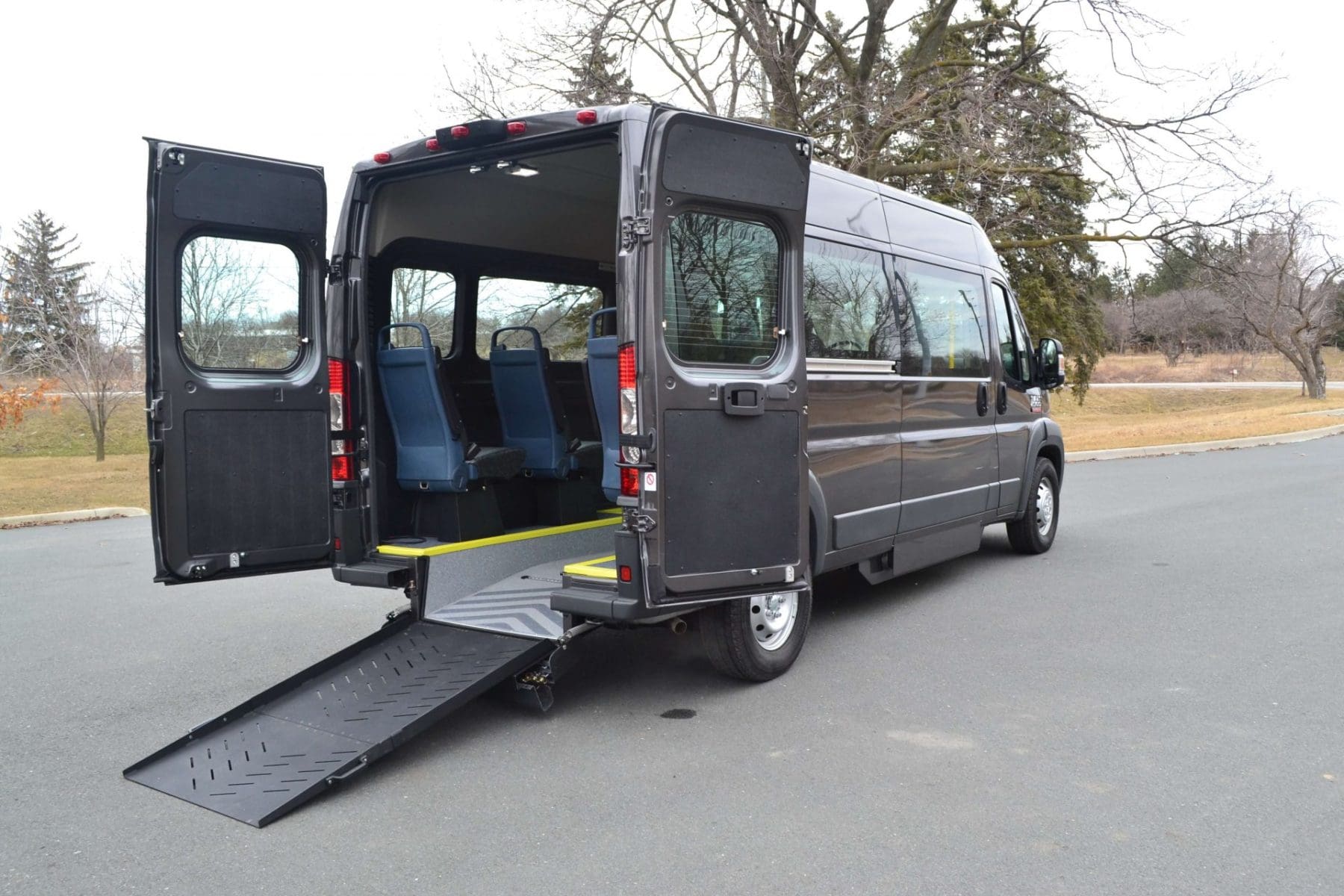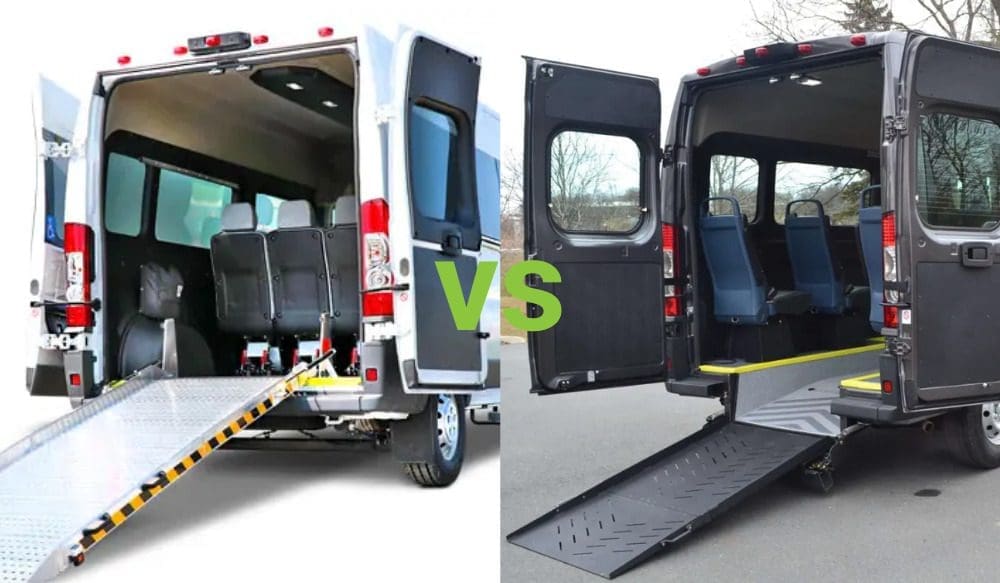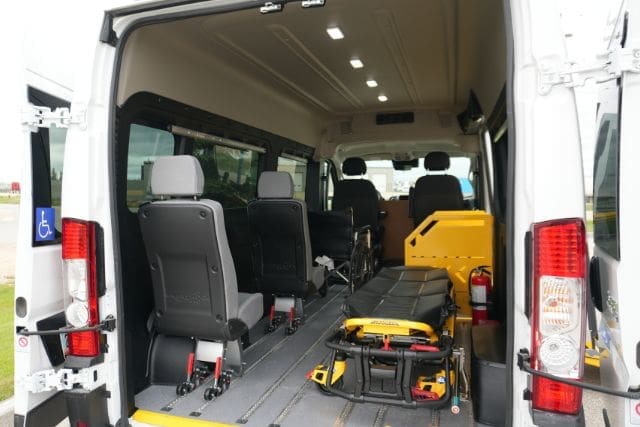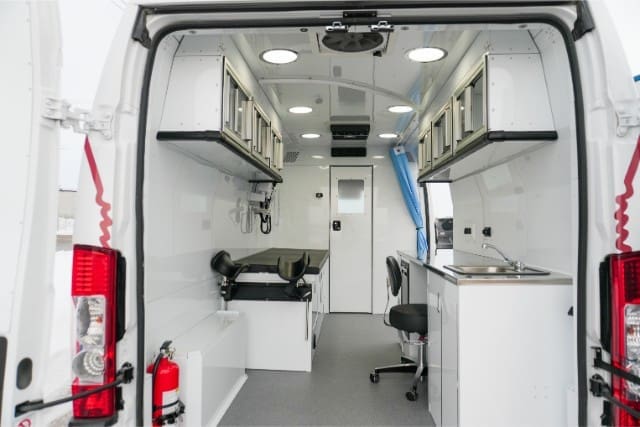When you invest in a wheelchair van for your organization, you expect your van to have the highest level of accessibility. You also expect the van you paid a lot for to last a long time.
So when your van forces walker-users to step up onto a higher level inside the van–potentially creating more barriers for your passengers–and it breaks down quicker than you were promised, this can add stress and resentment to your organization’s everyday life.
In this article, you’ll learn the differences between high-floor and low-floor wheelchair vans, their pros and cons, and who each option is right for.
At MoveMobility, we exclusively carry high floor options in our full-size line because they last longer, can have a ramp or a lift, and have a flat floor inside the van.
Although we do have low-floor options in our minivans, we have found through many years of experience that high-floor vans are the best because they are more accessible.
Differences in high-floor and low-floor wheelchair vans
There are two major differences between a high-floor and a low-floor wheelchair van: floor height and accessibility level and the ability to have a ramp or a lift.
1. Floor height and accessibility
Obviously, the main difference between a high-floor and a low-floor wheelchair van is the floor height itself.
In a high-floor van, nothing is done to change the floor height. This means we do not convert the van to have a high floor–no alterations are made in terms of floor height, and the floor is completely flat with no steps.
But, with a low-floor van, the manufacturer “cuts” the van’s floor and lowers the floor to decrease the ramp angle for wheelchair users getting into the van. Walk-on riders using the regular seats have to have enough mobility to climb up the step and then get into the seat.
2. Ramp or lift
The other major difference between a high-floor van and a low-floor van is whether or not it can have a ramp or a lift.
A ramp will be steeper in a high-floor van. We compensate for this by making the ramp longer and flattening the angle.
In a low-floor van, it’s more challenging to install a lift–and sometimes, it’s just impossible. Most low-floor vans have a ramp.
Pros of high-floor wheelchair vans
There are many pros to having a high-floor wheelchair van.
The flat floor
A high-floor wheelchair van has a flat floor, which makes it more accessible. Wheelchair users and walker users can both move functionally around the van with ease.
Ability to choose a ramp or a lift
You can choose a ramp or a lift with a high-floor van.
Ramps are typically better for walker-users with a higher level of mobility and average-sized wheelchairs.
Lifts are typically better for heavy, ambulatory wheelchairs.
If you want to learn about the pros and cons of ramps vs. lifts, check out this article.
Cons of high-floor wheelchair vans
The only major con of a high-floor wheelchair van is, for some organizations, the ramp.
A steep or long manual ramp
A manual ramp on a high-floor van is steeper and longer than the manual ramps you would see with a low-floor wheelchair van, but that’s not to say it is too steep or too long. At MoveMobility, we have an option for you to lower the suspension, which reduces the ramp incline.
An important thing to remember is that if you want a manual ramp for your high-floor wheelchair van, your workers will have to push the wheelchairs up the ramp manually.
So, if your organization needs efficiency and ease of use, a low-floor van with a shorter ramp may be a better option–but don’t forget about the availability of lifts for high-floor models.
A powered ramp stays the same no matter what floor height your van has.
Talk to a MoveMobility expert now to learn which is best for your organization.
Pros of low-floor wheelchair vans
One major pro of having a low-floor wheelchair van is the ramp and, by extension, the ramp’s accessibility.
A flat and short ramp
Having a low-floor wheelchair van means the ramp is flatter and shorter, making it easier for wheelchairs to be pushed up and walker users to walk up the ramp.
Cons of low-floor wheelchair vans
There are two major cons to having a low floor wheelchair van: having to step up a platform to get inside the van, and the impact that lowering the floor has on your vehicle.
The second platform inside the van

Because a manufacturer lowers the van floor, a second platform is inside the vehicle. This can be difficult for walker users (and anyone with mobility issues) because they have to step up to the second platform to access seating.
Adding “stress” to the vehicle
When a manufacturer lowers the floor of a van, it causes a lot of “stress” on the vehicle. The more modifications to a van decrease how long the van will run for.
This can cost your organization more money in repairs to maintain the vehicle.
Low visibility for riders
In a low-floor van, wheelchair users are seated low down in the vehicle, in the lowered channel. This means they can’t see out the windows.
Less comfortable because riders are so close to the ground
Due to the low floor, riders are quite low to the ground. This means they will feel every jostle, bump, and turn much more than they would in a high-floor van
This, combined with the louder noises, can create an uncomfortable passenger experience for your clients.
No flexibility for passenger seating
Lowering the van eliminates any flexibility for rearranging passenger seats and wheelchair positions. Wheelchairs can only be secured within the channel of the low floor, and seats are only available on the raised lip around the channel.
Who are high-floor wheelchair vans right for?
Organizations that transport a variety of wheelchair users, walker users, and ambulatory clients
A high-floor wheelchair van, like the Ford Transit or the Ram Promaster, is typically better for organizations that transport walker users or people with limited mobility because it doesn’t have that extra step up to access the seats.
At MoveMobility, our wheelchair vans have an AutoFloor. This means you get to customize your floorplan–changing around the seats and securing the wheelchairs where you need them.
With flexibility, you can cater to a wide range of mobility needs.
Who are low-floor wheelchair vans right for?
Organizations that want a ramp with a low incline
If a low incline is very important to your organization, a low-floor wheelchair van may be the right option.
Your next steps for choosing between high vs. low-floor wheelchair vans
You came to this article to find out if a high-floor or low-floor van is right for your organization.
Now, you know the differences between a low-floor and a high-floor van, their pros and cons, and who each option is right for.
Like I said previously, we only sell high floor full size vans at MoveMobility. For more information on high vs low floor wheelchair vans, talk to a MoveMobility expert now.
Or, learn more about wheelchair vans by checking out these related articles:








